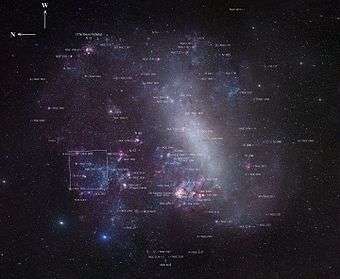N11 (emission nebula)
N11 (also known as LMC N11, LHA 120-N 11) is the brightest emission nebula in the north-west part of the Large Magellanic Cloud in the Dorado constellation.[3] The N11 complex is the second largest H II region of that galaxy, the largest being the Tarantula Nebula. It covers an area approximately 6 arc minutes across.[4] It has an elliptical shape and consists of a large bubble, generally clear interstellar area, surrounded by nine large nebulae.[5] It was named by Karl Henize in 1956.[6]
| Emission nebula | |
|---|---|
| superbubble | |
.jpg) A portion of LMC N11, with the NGC 1763 emission nebula at the top and NGC 1761 open cluster at the bottom Credit: NASA, ESA and Jesús Maíz Apellániz (Instituto de Astrofísica de Andalucía, Spain) | |
| Observation data: J2000.0 epoch | |
| Right ascension | 04h 56m 46.2s[1] |
| Declination | −66° 28′ 27″[1] |
| Distance | 160,000[2] ly |
| Constellation | Dorado |
| Physical characteristics | |
| Radius | 1,000 [3] ly |
| Designations | LMC N11, LHA 120-N 11, Bean Nebula |

When close-up, the nebula has pink clouds of glowing gas which resembles candy floss.[6] It has been well studied over the years and extends 1,000 light-years across.[3]
Its particularly notable features include a huge cavity measuring 80 by 60 pc and a five million year old central cluster (NGC 1761). It is surrounded by several ionized clouds where young O stars are forming.[7][8] Several massive stars are within it, including LH 9, LH 10, LH 13, LH 14. It includes a supernova remnant N11L.[9] In the very centre of NGC 1761 is a bright multiple star HD 32228 which contains a rare blue Wolf-Rayet star, type WC5 or WC6, and an O-type bright giant.[10]
Bean Nebula
The brightest nebulosity within N11 is the northern region N11B (NGC 1763), also known as the Bean Nebula because of its shape.
Other most notable nebulae
On N11B's north-east edge is the more compact N11A, known as the Rose Nebula, which has rose-like petals of gas and dust and are illuminated due to the massive hot stars within its centre.[11] It is also known as IC 2116 and was catalogued as a star HD 32340.
The east side of the N11 complex is N11C (NGC 1769), an emission nebula containing at least two compact open clusters.[12]
Outside the main "bubble" of N11 to the northeast is N11E, also known as NGC 1773, a small bright nebula containing several massive young stars. The south portion of the bubble is N11F, also called NGC 1760. The western portion of the bubble is faint and poorly-defined.[5]
To the south-west of N11 is the 7th magnitude red giant HD 31754, a foreground star/star system, lying close to our sightline with open cluster NGC 1733. Three farther galaxies visible from most southern deep space telescopes and observatories are west of N11: the pair PGC 16243 and PGC 16244; and LEDA 89996. To the south of them lie NGC 1731 and TYC 8889-619-1[3] which are part of the galaxy's N4 complex. The bright globular cluster NGC 1783 figures to the north of N11.
References
- "NED results for object LMC:N011". NED. Retrieved 5 November 2017.
- "A Cauldron of Newborn Stars". Sky and Telescope. 23 July 2010. Retrieved 5 November 2017.
- "N11 complex in LMC". astronomy and observation. Retrieved 5 November 2017.
- "Hubble view of the huge star formation region N11 in the Large Magellanic Cloud". Space Telescope. 22 June 2010. Retrieved 5 November 2017.
- Rosado, M.; Laval, A.; Le Coarer, E.; Georgelin Y., P.; Amram, P.; Marcelin, M.; Goldes, G.; Gach J., L. (1996). "Formation of the nebular complex N11 in the Large Magellanic Cloud". Astronomy and Astrophysics. 308. Bibcode:1996A&A...308..588R.
- "Hubble captures bubbles and baby stars". Space Telescope. 22 June 2010. Retrieved 5 November 2017.
- Nowajewsky, P.; Rubio, M. (2006). "IR Study of N11 in the LMC". Revista Mexicana de Astronomía y Astrofísica (Serie de Conferencias). 26. Bibcode:2006RMxAC..26..162N.
- "IR Study of N11 in the LMC". Harvard. Bibcode:2006RMxAC..26..162N.
- Naze, Y; Antokhin, I. I; Rauw, G; Chu, Y. -H; Vreux, J. -M; Vreux, J.-M (2004). "XMM-Newton observations of the giant HII region N11 in the LMC". Astronomy & Astrophysics. 418 (3): 841. arXiv:astro-ph/0402623. doi:10.1051/0004-6361:20035633.
- "Harry Observes the N11 complex in the LMC". MAAS. 16 November 2016. Retrieved 6 November 2017.
- "Hubble Captures Beautiful Baby Stars". Universe Today. 22 June 2010. Retrieved 5 November 2017.
- "Hubble Sees Hidden Treasure in Large Magellanic Cloud". NASA. 23 January 2013. Retrieved 6 November 2017.